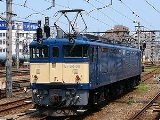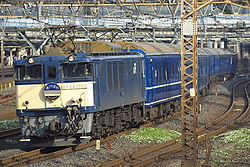
JNR Class EF64
Encyclopedia
History
The class was designed to replace the ageing EF16 class locomotives used on the steeply-graded ŌuOu Main Line
The is a railway line in Japan, operated by the East Japan Railway Company . It runs from Fukushima Station in Fukushima, Fukushima through Akita Station in Akita, Akita to Aomori Station in Aomori, Aomori Prefecture...
and Chūō
Chuo Main Line
The , commonly called the Chūō Line, is one of the major trunk railway lines in Japan. It runs between Tokyo and Nagoya, although it is the slowest direct railway connection between the two cities; the coastal Tōkaidō Main Line is slightly faster, while the Tōkaidō Shinkansen is the fastest rail...
mainlines in the early 1960s.
Two prototype locomotives, EF64 1 and 2, were delivered in 1964, built by Tōshiba and Kawasaki Sharyō respectively. The basic body design was based on that of the earlier EF62s
JNR Class EF62
A total of 54 Class EF62 DC electric locomotives were built between 1962 and 1969 for use hauling passenger and freight on the Shinetsu Main Line and particularly over the extreme 66.7‰ gradient of the Usui Pass between Yokokawa and Karuizawa...
but with the more usual Japanese Bo-Bo-Bo wheel arrangement. Livery from the start was all-over blue with just the lower cab ends painted cream.
Full production started in 1965, continuing to 1976 with loco EF64 79. Minor variations within the class included the discontinuation of the cab ventilation grilles above the marker lights from EF64 46 onward. Locos EF64 1 to 12 and EF64 29 to 55 were equipped with train-heating generators for passenger use, and are distinguishable by the train heating indicator lights next to the cab doors. The DT120A/DT121A bogies were virtually identical to those used on the EF70 class.
The first batch of locos, consisting of EF64 1 to 12, were assigned to the Ōu Main Line
Ou Main Line
The is a railway line in Japan, operated by the East Japan Railway Company . It runs from Fukushima Station in Fukushima, Fukushima through Akita Station in Akita, Akita to Aomori Station in Aomori, Aomori Prefecture...
between Fukushima
Fukushima Station (Fukushima)
is a railway station located in the city of Fukushima, Fukushima, Japan.-Lines:*JR East**Tōhoku Shinkansen**Yamagata Shinkansen**Tōhoku Main Line**Ōu Main Line*AbukumaExpress** Abukuma Express Line*Fukushima Transportation** Iizaka Line-Layout:...
and Yonezawa
Yonezawa Station
Yonezawa Station is a JR East railway station located in Yonezawa, Yamagata Prefecture, Japan.-History:*15 May 1899 - Station begins operation as the end of the line from Fukushima.*21 April 1900 - Lines are extended past Yonezawa to Akayu Station....
, where their duties included assisting KiHa80 Tsubasa DMUs over the steep gradients.
The second batch, from EF64 13 onward, were allocated to the Chūō Main Line
Chuo Main Line
The , commonly called the Chūō Line, is one of the major trunk railway lines in Japan. It runs between Tokyo and Nagoya, although it is the slowest direct railway connection between the two cities; the coastal Tōkaidō Main Line is slightly faster, while the Tōkaidō Shinkansen is the fastest rail...
for use primarily on freight duties. With the conversion of the Ōu Main Line from 1,500 V DC to 20 kV AC electrification in October 1968, the first 12 locos were transferred to the Chūō Main Line.
Nowadays, with the exception of a handful of locos owned by JR East/Central/West for charter and occasional passenger haulage, the subclass is divided evenly between Shiojiri and Aichi depots (JR Freight) at either end of the Chūō Line.
EF64-1000 subclass

JNR Class EF81
The EF81 class of electric locomotives are Bo-Bo-Bo wheel arrangement multi-voltage AC/DC electric locomotives operated on passenger and freight services in Japan.-EF81-300:...
locomotives. A total of 53 EF64-1000s were built by 1982, all by Kawasaki and Tōyō Electric. Locos from EF64 1033 onward were built without train-heating generators.
Apart from a handful of locos owned by JR East and based at Takasaki and Nagaoka depots for use on sleeper and charter train haulage, the subclass is largely based at Takasaki for Jōetsu Line
Joetsu Line
The is a major rail line in Japan. Part of the JR East system, it runs from Takasaki Station in Takasaki, Gunma Prefecture, to Miyauchi Station in Nagaoka, Niigata Prefecture, linking the northwestern Kantō region and the Sea of Japan coast of the Chūbu region...
freight duties. Locos EF64 1046 to 1050, however, are based at Okayama depot for use on Hakubi Line
Hakubi Line
The is a railway line operated by West Japan Railway Company in the mountainous area of the Chūgoku region of Japan. It begins at the south end of Okayama Prefecture at Kurashiki Station in Kurashiki, passing through Niimi Station on the west side of Niimi, and terminating at Hōki-Daisen Station...
freight duties.
EF64 1030 and 1031, owned by JR East, both have EMU-couplers and jumper sockets, and these locos are frequently used for hauling new rolling stock from the Niitsu factory to Tōkyō via the Jōetsu Line, and also for hauling withdrawn rolling stock to Nagano.
Life-extension refurbishment
From 1996, the EF64-0s underwent a life-extension refurbishment programme, with EF64 67 the first locomotive treated. Refurbishment was carried out at Ōmiya and Hiroshima Works, with locos initially released in the JR Freight livery of two-tone blue and light grey. Minor livery variations were implemented during the programme, and locos treated at Hiroshima were distinguished by having mustard-coloured cab gangway doors.From 2004 onward, the JR Freight livery was simplified by using a single shade of dark blue and light grey.
The first EF64-1000, EF64 1015, also underwent refurbishment in 2003, appearing in the then-standard JR Freight two-tone blue and light grey livery. However, following complaints from staff about the difficulties in visually distinguishing the loco from refurbished EF65s, a new livery was devised and applied to the next loco to be refurbished, EF64 1009, consisting of standard blue with broad white diagonal bands and large red "JRF" bodyside logos (see front cover photo of Bullet-In 52). The first Okayama-based EF64-1000, EF64 1047 was refurbished in July 2006 at Hiroshima Works, and this was released in a further simplified livery of all-over blue with white bodyside stripe and light grey lower cab front.
Withdrawals
There have been no accident-related withdrawals of EF64s, but the first member of the class was withdrawn in 2003 following the introduction of the JR Freight Class EH200JR Freight Class EH200
The EH200 class of electric locomotives are Bo-Bo+Bo-Bo wheel arrangement two-unit DC freight locomotives operated by JR Freight in Japan.The locomotives are built at the Tōshiba factory in Fuchū, Tokyo...
. As of April 2007, 24 EF64-0s had been withdrawn, and a further 9 were in storage. Okayama-based EF64-1021 has also been withdrawn, but the EF64-1000s are expected to remain in service for many years yet following life-extension refurbishment.
Livery variations
- EF64 35 Repainted into white/blue Euroliner livery in August 1990. Although the Euroliner set was withdrawn in April 2005, EF64 35 is currently allocated to Shizuoka depot (JR Central) and based at Nagoya.
- EF64 37 Painted all-over brown in 2003 to celebrate 100th anniversary of Chūō Mainline between Kōfu and Enzan. Allocated to Takasaki depot (JR East), but normally based at Kōfu. Used on charter train and engineering train duties.
- EF64 41 Painted all-over brown with gold numbers in May 2006.
- EF64 66 Repainted into white/blue Euroliner livery in August 1985 for use with the 12 series Euroliner Joyful TrainJoyful Trainis the name given to railway rolling stock or train sets operated by the JR Group in Japan primarily for charters, special events, tourist excursions, and other similar purposes.-History:...
set. This was the first EF64 to receive a livery other than standard blue. Operated by JR Central, it was withdrawn in March 2007 and is currently stored at Hamamatsu Works. - EF64 77 Received a white bodyline stripe and brass depot plates when it hauled the imperial train on the Chūō Mainline in October 1986. Subsequently refurbished and repainted.
- EF64 1001 Painted brown with a white stripe. Allocated to Takasaki depot (JR East), for use on charter train duties, particularly in conjunction with D51 498 and EF55 1.
Preserved examples
- EF64 18 Preserved in park close to Katsunuma-budōkyō StationKatsunuma-budokyo Stationis a railway station of Chūō Main Line, East Japan Railway Company , in Katsunuma-Hishiyama, in the city of Kōshū, Yamanashi Prefecture, Japan.This station is located near the Ōhikage Tunnel, built in 1903.-Layout:- History :...
on the Chūō Mainline.

